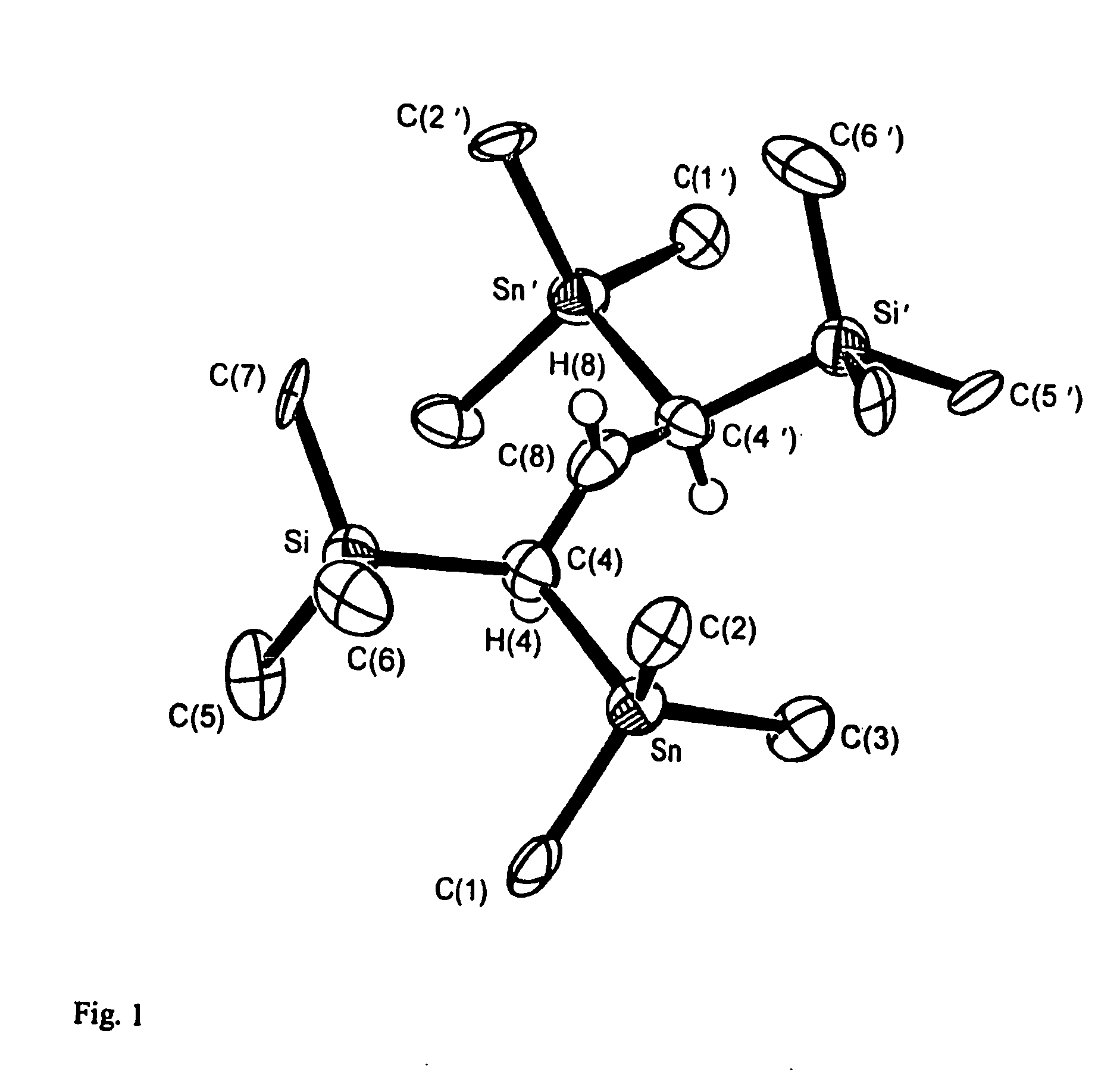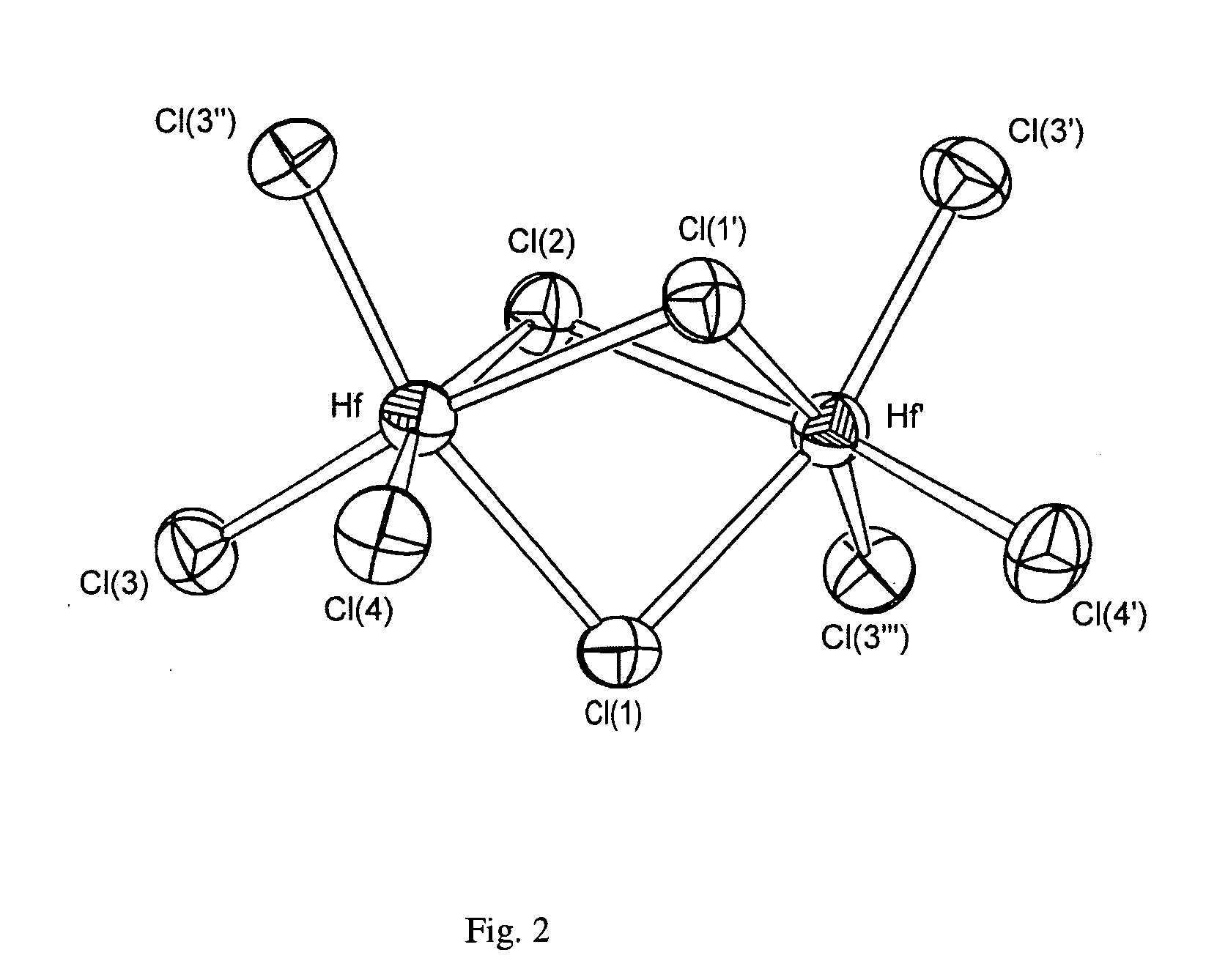Process for preparing isobutylene-based polymers
a polymer and polymer technology, applied in the direction of organic compounds, organic chemistry, tin organic compounds, etc., can solve the problems of complex counter anion not assisting in or causing proton elimination, general instability too large to be isolable, etc., to achieve high catalytic activity in isobutene copolymerisation
- Summary
- Abstract
- Description
- Claims
- Application Information
AI Technical Summary
Benefits of technology
Problems solved by technology
Method used
Image
Examples
example 1
Synthesis of [CH{CH(SiMe3)(SnMe3)}2]+Zr2Cl9−
[0102] All the manipulations have been carried out under strict exclusion of oxygen and moisture in a nitrogen inert atmosphere. A solution of Me3SnCl (0.6 g, 3.0 mmol) and Me3SiCH═CHCH(SiMe3)(SnMe3) (1.0 g, 2.9 mmol) in CH2Cl2 (30 mL) was transferred to ZrCl4 (1.4 g, 6.0 mmol). On stirring for 4 h at room temperature the solid dissolved and the solution turned yellow. After filtration the amount of solvent was reduced to 10 mL. Crystallization at −30° C. afforded the title compound in ca 50% yield, mp. 109° C. Solid state magic-angle spinning 13C NMR (relative to tetramethylsilane): δ−1, 0, 3 (SiMe3, SnMe3); 70 (CH); 217 (CH+), 29Si NMR: δ 1 ppm.
example 2
Synthesis of [CH{CH(SiMe3)(SnMe3)}2]+Hf2Cl9−
[0103] Following the method of Example 1, a solution of Me3SnCl (0.6 g, 3.0 mmol) and Me3SiCH═CHCH(SiMe3)(SnMe3) (1.0 g, 2.9 mmol) in CH2Cl2 (30 mL) was transferred to HfCl4 (6.0 mmol). On stirring for 4 h at room temperature the solid dissolved and the solution turned yellow. After filtration the amount of solvent was reduced to 10 mL. Crystallization at −30° C. afforded the title compound in ca. 50% yield, mp. 120° C. The 13C and 29Si solid-state NMR spectroscopic data were essentially identical to Example 1.
[0104]FIG. 1 shows the crystal structure of the cation in [CH{CH(SiMe3)(SnMe3)}2]+Hf2Cl9−, FIG. 2 shows the crystal structure of the anion in [CH {CH(SiMe3)(SnMe3)}2]+Hf2Cl9.
example 3
Isobutene Polymerization
[0105] Into a 250 mL 3-necked reaction flask, equipped with a magnetic follower and cooled to −78° C. with a dry ice / acetone bath, was condensed 100 mL of isobutene (dried by passing through 10 percent weight sodium on aluminum oxide and 4A molecular sieves). 30 mg (30 [mol) of [HC{CH(SiMe3)(SnMe3))2]+[Zr2Cl9]− was dissolved in 2 mL of dichloromethane. This initiator solution was then transferred to the rapidly stirred (1000 / min) isobutene (still cooled to −78° C.), via syringe under positive nitrogen pressure. The mixture was stirred for 3 minutes, until a significant increase in viscosity was observed. At this point, the reaction was terminated by addition of methanol (10 mL). The reaction mixture was poured into methanol (200 mL) to precipitate the polymer. The excess monomer was allowed to evaporate, the solvent decanted, then the polymer was dried in an oven at 50° C. to constant weight. The yield of polyisobutene was 3.6 g, Mn=160,000 and Mw=233,000.
PUM
| Property | Measurement | Unit |
|---|---|---|
| degree of polymerization | aaaaa | aaaaa |
| temperatures | aaaaa | aaaaa |
| temperature | aaaaa | aaaaa |
Abstract
Description
Claims
Application Information
 Login to View More
Login to View More - R&D
- Intellectual Property
- Life Sciences
- Materials
- Tech Scout
- Unparalleled Data Quality
- Higher Quality Content
- 60% Fewer Hallucinations
Browse by: Latest US Patents, China's latest patents, Technical Efficacy Thesaurus, Application Domain, Technology Topic, Popular Technical Reports.
© 2025 PatSnap. All rights reserved.Legal|Privacy policy|Modern Slavery Act Transparency Statement|Sitemap|About US| Contact US: help@patsnap.com


